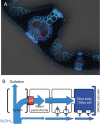Transport of silicon from roots to panicles in plants
- PMID: 21785256
- PMCID: PMC3171283
- DOI: 10.2183/pjab.87.377
Transport of silicon from roots to panicles in plants
Abstract
Silicon (Si) is the most abundant minerals in soil and exerts beneficial effects on plant growth by alleviating various stresses. The transport of Si from soil to the panicles is mediated by different transporters. Lsi1, belonging to a NIP group of the aquaporin family, is responsible for the uptake of Si from soil into the root cells in both dicots and monocots although its expression patterns and cellular localization differ with plant species. The subsequent transport of Si out of the root cells towards the stele is medicated by an active efflux transporter, Lsi2. Lsi1 and Lsi2 are polarly localized at the distal and proximal sides, respectively, of both exodermis and endodermis in rice root. Silicon in the xylem sap is presented in the form of monosilicic acid and is unloaded by Lsi6, a homolog of Lsi1 in rice. Lsi6 is also involved in the inter-vascular transfer of Si at the node, which is necessary for preferential Si distribution to the panicles.
Figures







Similar articles
-
Functions and transport of silicon in plants.Cell Mol Life Sci. 2008 Oct;65(19):3049-57. doi: 10.1007/s00018-008-7580-x. Cell Mol Life Sci. 2008. PMID: 18560761 Free PMC article. Review.
-
Silicon transporters in higher plants.Adv Exp Med Biol. 2010;679:99-109. doi: 10.1007/978-1-4419-6315-4_8. Adv Exp Med Biol. 2010. PMID: 20666227 Review.
-
Orchestration of three transporters and distinct vascular structures in node for intervascular transfer of silicon in rice.Proc Natl Acad Sci U S A. 2015 Sep 8;112(36):11401-6. doi: 10.1073/pnas.1508987112. Epub 2015 Aug 17. Proc Natl Acad Sci U S A. 2015. PMID: 26283388 Free PMC article.
-
A cooperative system of silicon transport in plants.Trends Plant Sci. 2015 Jul;20(7):435-42. doi: 10.1016/j.tplants.2015.04.007. Epub 2015 May 13. Trends Plant Sci. 2015. PMID: 25983205 Review.
-
A pericycle-localized silicon transporter for efficient xylem loading in rice.New Phytol. 2022 Apr;234(1):197-208. doi: 10.1111/nph.17959. Epub 2022 Feb 2. New Phytol. 2022. PMID: 35020209
Cited by
-
Influence of Silicon on Biocontrol Strategies to Manage Biotic Stress for Crop Protection, Performance, and Improvement.Plants (Basel). 2021 Oct 12;10(10):2163. doi: 10.3390/plants10102163. Plants (Basel). 2021. PMID: 34685972 Free PMC article. Review.
-
The Investigation of Silicon Localization and Accumulation in Citrus.Plants (Basel). 2019 Jul 1;8(7):200. doi: 10.3390/plants8070200. Plants (Basel). 2019. PMID: 31266195 Free PMC article.
-
Engineered silica nanoparticles alleviate the detrimental effects of Na+ stress on germination and growth of common bean (Phaseolus vulgaris).Environ Sci Pollut Res Int. 2017 Sep;24(27):21917-21928. doi: 10.1007/s11356-017-9847-y. Epub 2017 Aug 5. Environ Sci Pollut Res Int. 2017. PMID: 28780690
-
Functional characterization of a silicon transporter gene implicated in silicon distribution in barley.Plant Physiol. 2012 Nov;160(3):1491-7. doi: 10.1104/pp.112.204578. Epub 2012 Sep 19. Plant Physiol. 2012. PMID: 22992512 Free PMC article.
-
A Review on Si Uptake and Transport System.Plants (Basel). 2019 Mar 29;8(4):81. doi: 10.3390/plants8040081. Plants (Basel). 2019. PMID: 30934978 Free PMC article. Review.
References
-
- Sommer M., Kaczorek D., Kuzyakov Y., Breuer J. (2006) Silicon pools and fluxes in soils and landscapes—a review. J. Plant Nutr. Soil Sci. 169, 310–329
-
- Epstein E. (1999) Silicon. Annu. Rev. Plant Physiol. Plant Mol. Biol. 50, 641–664 - PubMed
-
- Ma, J.F. and Takahashi, E. (2002) Soil, Fertilizer, and Plant Silicon Research in Japan. Elsevier, Amsterdam.
Publication types
MeSH terms
Substances
LinkOut - more resources
Full Text Sources
Miscellaneous

